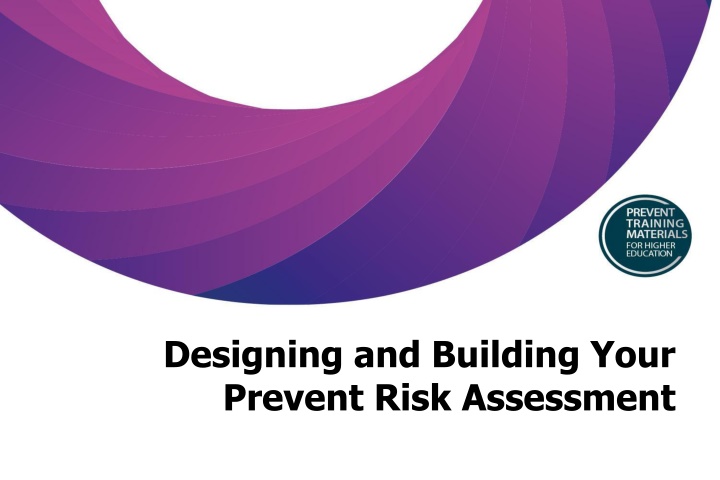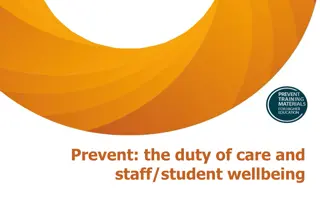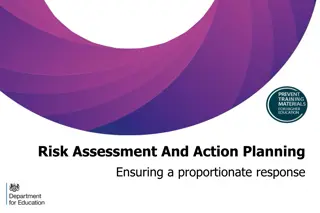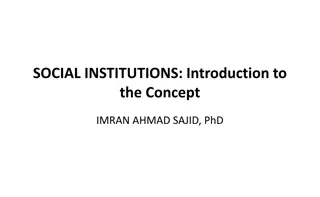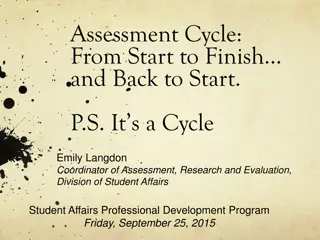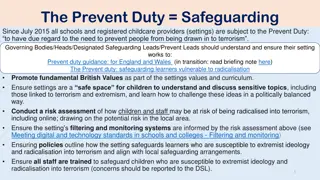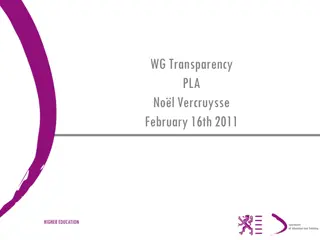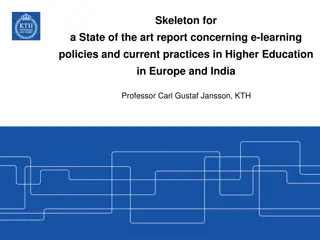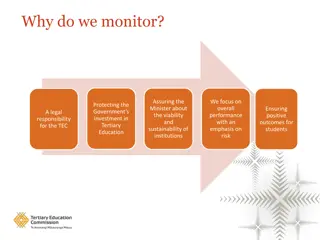Effective Strategies for Prevent Risk Assessment in Higher Education Institutions
Explore the essential aspects of Prevent risk assessment and action planning for staff in Higher Education Institutions (RHEBs). Learn about the key components, process guidelines, and ownership responsibilities for developing and maintaining effective risk assessments. Discover insights on what a Prevent risk assessment should encompass and how to ensure regular updates and executive oversight.
Download Presentation

Please find below an Image/Link to download the presentation.
The content on the website is provided AS IS for your information and personal use only. It may not be sold, licensed, or shared on other websites without obtaining consent from the author.If you encounter any issues during the download, it is possible that the publisher has removed the file from their server.
You are allowed to download the files provided on this website for personal or commercial use, subject to the condition that they are used lawfully. All files are the property of their respective owners.
The content on the website is provided AS IS for your information and personal use only. It may not be sold, licensed, or shared on other websites without obtaining consent from the author.
E N D
Presentation Transcript
Designing and Building Your Prevent Risk Assessment
Risk assessment These slides are to support staff within RHEBs with responsibility for Prevent risk assessments and action plan. The advice covers: what does a Prevent risk assessment and action plan achieve and what should be covered? process and ownership how to develop a Prevent risk assessment and action plan sources of information and intelligence components of a good risk assessment
What should a Prevent risk assessment look like? There is no prescriptive format or style for a Prevent risk assessment or action plan & institutions have the flexibility to utilise existing corporate models or devise one to suit their own needs. It is acceptable and often useful to combine the Prevent risk assessment with the action plan. However, it should: reflect the specifics of your institution and not obviously be a generic document clearly identify when it was last updated, reviewed, authorship and importantly executive oversight and ownership demonstrate how risks have been identified and level of risk determined be part of a cycle not a one off event
What areas should your Prevent risk assessment cover? The Prevent Statutory Guidance is a good starting point for this and outlines a number of areas that should be given consideration. The Statutory Guidance is not intended to be prescriptive in its application and institutions are urged to consider it in a manner that is proportionate to risk and personal to their institution. The higher education guidance covers: risk Assessment Prevent action plan Partnership staff training welfare & pastoral care safety online speakers & events
Process and ownership It is good practice to establish a cycle of review and refresh for risk assessments and action plans. Whilst no formal timeline for this exists it is suggested that reviews should be linked to publishing of CTLPs* and risk briefings Operational responsibility and executive ownership should be clearly defined Published (and adhered to) reporting timetables should be established to allow accountability and transparency Internal forums (existing or Prevent specific) to manage oversight and reporting and to provide transparency Consultation amongst students, staff, external stakeholders and communities should be a key strand of annual process OfS submission timelines Once you have the risk assessment and action plan in place it is important you use them and regularly update them
Risk and the organisation Planning and management of risks and their impacts requires cross-department and trans-organisational planning and consultation. Linking between management and planning efforts. Prevent risk planning cannot be conducted in isolation. Considering the organisation s needs, context and the need to maintain it s normal functions (a proportionate response) External and internal forces, security and information management, human capital and training, risk management strategy, culture, demographics and organisational character Prevent management and planning must ensure and include consultation with internal and external stakeholders. No one-size tick-box answer - every organisation is unique!
Risk assessment information sources Risk assessments must be based on a broad range of information and intelligence to ensure all potential risks are identified and understood in the context of your institution and it s community This might include consideration of differing risks on different campuses/sites and risks to specific communities, groups or events Remember the Prevent Statutory Guidance states that your risk assessment is expected to: assess where & how students might be at risk of being drawn into terrorism . campus and student welfare, including equality and diversity and the safety and welfare of students and staff . assess the physical management of the university estate (Paragraph 19, Prevent statutory guidance for higher education)
Sources of information and intelligence: high- level sources Police Counter-Terrorism Local Profiles (CTLP) Published partnership intelligence reports OfS Prevent Review feedback and sector good practice sharing Other sector intelligence
Sources of information and intelligence: local sources Local Authority Prevent Plans Local Policing intelligence Regional Prevent Coordinators Channel trends Extremist speakers/groups activity Anti-Prevent/CT lobbying/activism TACT convictions/releases/travellers/returnees
Components of a good risk assessment/action plan Component Description Clear identification of risk area & specific hazards These may be national/local, geographic, institution or sector specific Rank the Severity & Likelihood of risks Usually based on a 1-5 scale Clear rating of risks Severity x Likelihood = assessment of risk. High/Medium/Low categories allows prioritisation actions Identification of existing mitigations should identify future actions & areas of weakness Required mitigation will establish new or ongoing actions for action plan Clearly established (& communicated) ownership & timelines for completion/review of actions Link to organisational business processes, CTLP updates & OFS timelines
An example of a risk assessment matrix Probability Rating Severity of impact Rating Almost certain 5 Catastrophic 5 Very likely 4 Major 4 Likely 3 Moderate 3 Unlikely 2 Minor 2 Improbably 1 None or trivial 1 Low risk 1 to 6 Medium risk 7 to 11 High risk 12 +
